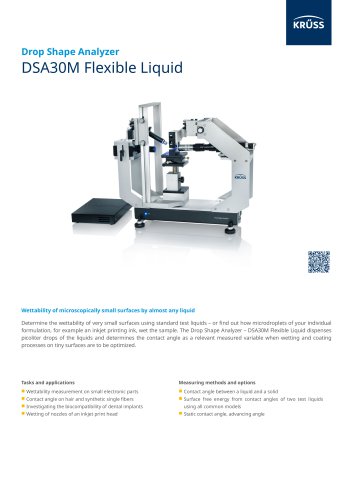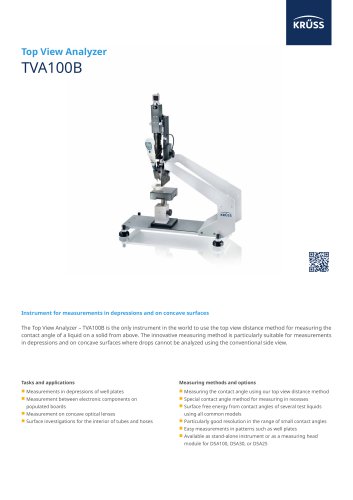 Website:
KRÜSS GmbH
Website:
KRÜSS GmbH
Group: Krüss
Catalog excerpts

Technical Note Roll-Off of Sliding Angle and Dynamic Contact Angles Technical note: Industry section: Method: Keywords: Drop Shape Analyzer – DSA100 Drop Shape Analyzer – DSA30 sessile drop, tilting table, dynamic contact angle Inclination to know-how Professional measurement of the roll-off or sliding angle and dynamic contact angle Surfaces from which raindrops simply roll off and take the dirt with them – the popular trademark Lotus-Effekt® describes the properties of hydrophobic surfaces which have a nanostructure similar to that of the lotus leaf. Manufacturers make use of research into this plant for façade paints and other coatings such as nanoimpregnations or surface-treated glass for windscreens. Fig. 1: The lotus leaf: a symbol of purity thanks to natural “nanotechnology” A measuring method for hydrophobic and self-cleaning surfaces – nanostructured or not – is the study of the roll-off behavior of drops on inclined surfaces. However, to date there has been no standard procedure that adequately takes such limiting conditions as drop volume or tilting speed into consideration. In this article we present the results of a comprehensive series of measurements that indicate an approach to the comparability of measurements of the roll-off angle and the dynamic contact angle of drops on inclined surfaces. KRÜSS GmbH | Borsteler Chaussee 85 | 22453 Hamburg | Germany | www.k
Open the catalog to page 1
Inclined measurements with KRÜSS contact angle instruments KRÜSS contact angle measuring instruments investigate the wettability of solids by depositing drops on them whose video image is then analyzed. The measured contact angle is the angle between the drop contour and the surface line of the sample (baseline); it is a measure of the wettability and allows – for measurements with different test liquids – the calculation of the surface free energy of the solid. In inclined measurements the focus is on the behavior of the drop when the surface forms an inclined plane. Attention is given to...
Open the catalog to page 2
Between 0.5 and 2°/s the differences in SA are within the measurement scatter range. From 3°/s the tilting speed shows a clear influence on the roll-off behavior. Influence of the drop volume Fig. 6: Movement of the three-phase points as a criterion for SA In the measurements described here under continuous tilting, the angle of inclination at which the position of the slowly moving three-phase point is displaced by 40 pixels is defined as being the SA. The influence of the drop volume on the SA is obvious: the greater weight means that there will be a stronger force along the tilted...
Open the catalog to page 3
Determining the constant range When tilting starts the drop does not move before the SA is reached, but it becomes deformed. The angle measured at the lower side becomes larger, that at the upper side smaller (see Fig. 3). However, these angles do not say a lot about the wetting properties, because they are primarily formed by the deformation resulting from the weight of the drop. Even when the drop starts moving above the SA, it takes some time before constant values are obtained at both sides of the drop. It is these plateau values that give required quantities: the advancing angle and...
Open the catalog to page 4All KRÜSS GmbH catalogs and technical brochures
-
DROP SHAPE ANALYZER – DSA30M
2 Pages
-
DSA30M Flexible Liquid
2 Pages
-
Product Overview 2025
84 Pages
-
Tensíío
2 Pages
-
Ayríís
2 Pages
-
FORCE TENSIOMETER – K20
2 Pages
-
FORCE TENSIOMETER – K6
1 Pages
-
TOP VIEW ANALYZER – TVA100B
2 Pages
-
DROP SHAPE ANALYZER – DSA30
2 Pages
-
DROP SHAPE ANALYZER – DSA30R
2 Pages
-
Drop Shape Analyzer DSA25
2 Pages
-
DROP SHAPE ANALYZER – DSA100
2 Pages
-
Dynamic Foam Analyzer DFA100
2 Pages
-
DSA100, DSA30, EasyDrop
5 Pages
-
DSA100
3 Pages































